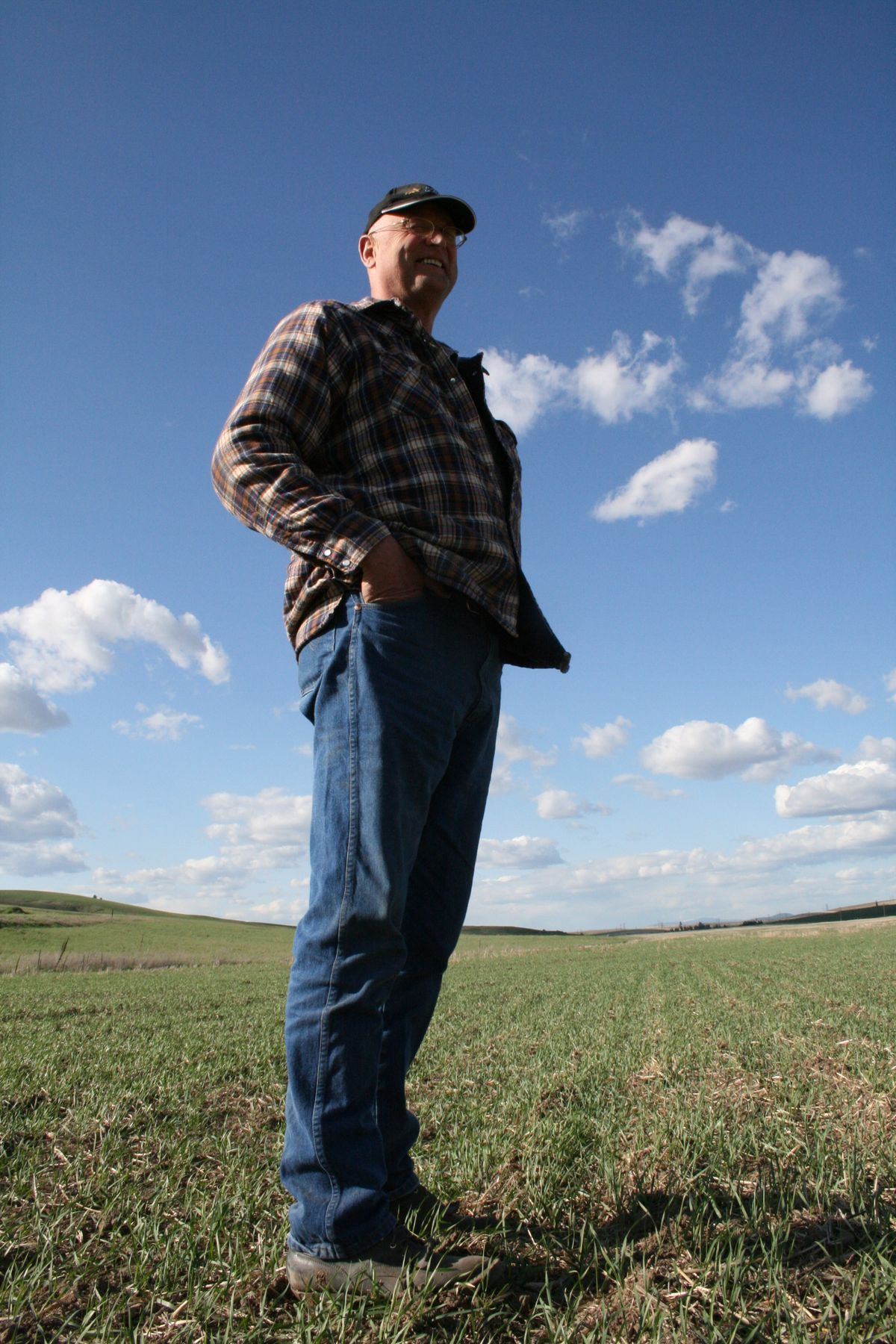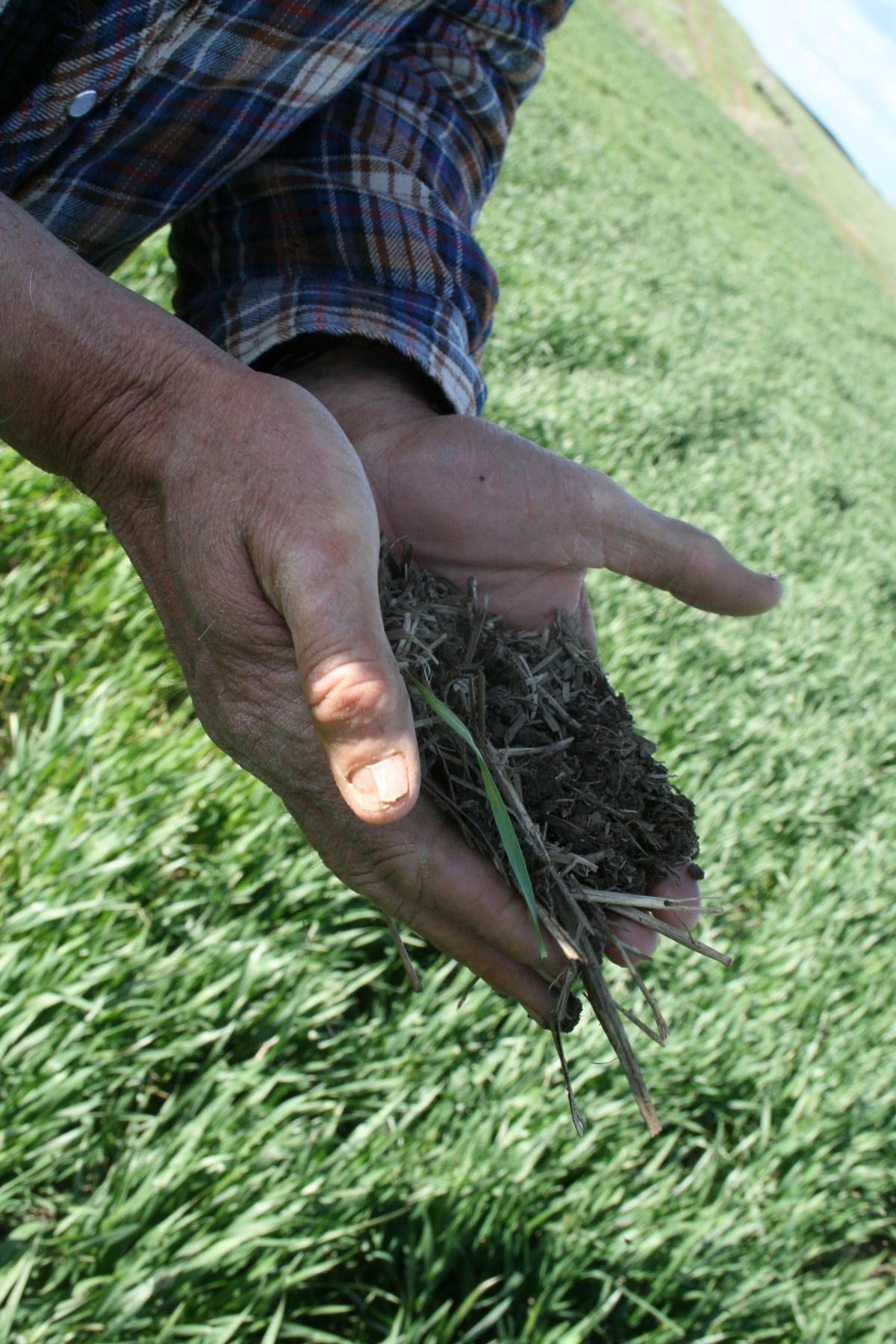Shepherding the soil
Spokane-area growers finding success with no-till methods
(Megan Cooley / Down to Earth NW Correspondent)
Fred Fleming bends down on both knees and claws at the dirt on the Reardan wheat farm that’s been in his family for almost 120 years.
He produces a handful of soil, leans into it, and inhales, admiring the dirt the way an oenophile embraces a good glass of wine.
“Can you smell the bouquet? That’s all the organisms working,” says Fleming.
An hour later, Fleming steps onto his neighbor’s farm and repeats the ritual. Instead of a handful of dark, earthy-smelling soil, this dirt feels dry and dusty. It looks pretty—smooth and consistently brown, the way farms are “supposed” to appear before the crops grow—but it lacks Fleming’s rich aroma.
The difference, he explains, is that his neighbor tills the soil after each harvest, clearing the fields for the next crop and creating a blank slate for new seeds.
Fleming, 59, lets his wheat stalks die and decompose on the fields, then uses a special machine that pokes new seeds into the messy remains. The stubble left behind looks ratty, but feeds the worms that produce the manure that fertilizes the soil. The stubble also acts like mulch, holding in moisture and keeping weeds at bay.
So while the conventional farm’s dirt has the consistency and appearance of brown powdered sugar (and perhaps the nutritional void), Fleming’s is as hearty, rich and robust as a winter stew.
Fleming is a co-founder of Shepherd’s Grain, an alliance of 32 Inland Northwest family farms that grow wheat following the same “no-till” method. Shepherd’s Grain flour is used by bread makers throughout the Northwest, including the Davenport Hotel, Luna restaurant, Washington State University’s dining service, HearthBread BakeHouse, Yoke’s Fresh Markets and Hot Lips Pizza, a pizzeria chain in Portland, Ore.
Although Shepherd’s Grain flour isn’t organic (Fleming says farming on a scale as large as these farmers do simply cannot be done without herbicide like Roundup), it’s more sustainable than conventional farming.
No-till farming drastically reduces soil erosion, lessening soil runoff that goes into streams and rivers.
There’s a ridge on Fleming’s farm that shows just how serious this problem is. On one side is land that the family hasn’t farmed. At least a foot lower, there’s the land his father tilled harvest after harvest for decades. The repeated tilling is the reason for the difference in elevation, Fleming says.
To kill the weeds without herbicide, and thus go organic, Shepherd’s Grain farmers would have to till the soil, he says. Instead, “99.9 percent of our soil stays on the farm now” rather than being blown or washed away in heavy wind or rains.
“If we were tilling and were organic, even the organic chemistry would leave the farm,” Fleming says. “It then becomes a liability in the environment.”
Meanwhile, the no-till method involves rotating different crops so disease and pest problems don’t grow, eliminating the need for chemicals to treat those issues.
Another benefit of no-till is that it uses less fuel than conventional farming, which requires tractors to make five to eight passes over a field at the start of each season—cultivating fields, spraying herbicides, fertilizing, seeding, and harrowing to smooth out soil clumps left behind by plowing.
No-till requires two trips: once to spray the herbicide and once to plant seeds. Fleming says his diesel fuel consumption has dropped by almost one-third since converting to no-till.
“If you’re doing this system, you protect the soil, you protect the environment,” he said.
On top of following a farming method that uses less fuel on the fields, using Shepherd’s Grain means your flour (or baked goods made from it) travels fewer food miles to reach you than flour made from wheat grown in the Dakotas, Kansas or Canada, where most of the wheat consumed in the Spokane area grows.
That most of our wheat comes from far away may baffle anyone who’s driven through the wheat-covered Palouse. Actually, 85 to 90 percent of the grain grown in eastern Washington heads overseas.
Ten years ago, Fleming and business partner Karl Kupers began talking about how to “shift the paradigm,” Fleming says.
By 2002, Shepherd’s Grain was born.
“We have a great product, at a reasonable price, and we farm in this sustainable manner. If the consumer understands this, they can seek out a product that’s local, and trace it back to the land,” Fleming says. “I can tell you the farmer it comes from.”
(Fleming recommends visiting www.findthefarmer.com, a site hosted by the whole-wheat flour company Stone-Buhr, which uses Shepherd’s Grain. Visitors can key in the “lot code” printed on the top of their flour bag, and a map will appear with the names of the Northwest farmers who grew the wheat.)
Shepherd’s Grain prices are reasonable—more reasonable than you would expect from a food product tagged “sustainable”— largely because they produce wheat on a bigger scale than, say, a farmer at a farmers’ market.
While Fleming says there’s an important role for small-scale farming in the local community, you need to involve mid-size farms, like the ones that are part of Shepherd’s Grain, to bring sustainably-grown food to the masses.
“We have to work with the larger mills. … We work with large and mid-size distributors like FSA (Food Services of America) and URM (United Retail Merchants),” he says. “If you don’t have that ‘big-boy’ system, you can’t take the volume of product we produce and put it in consumers’ hands.”
Roundup and names like FSA and URM can make local food advocates shudder. But as a March/April 2009 article about Shepherd’s Grain in Mother Jones magazine suggests, environmentalists might need to tolerate alternative models of sustainability in order to “bridge the gap between where our food system is today and where it needs to be.”
The article, by Paul Roberts, turns the concept of “food miles” on its head.
“In theory, locally-grown foods have traveled shorter distances and thus represent less fuel use and lower carbon emissions—their resource footprint is smaller,” Roberts writes.
“And yet, for all the benefits of a local diet, eating locally doesn’t always translate into more sustainability. Because the typical farmers’ market is supplied by dozens of different farms, each transporting its crops in a separate van or truck, a 20-pound shopping basket of locally-grown produce might actually represent a larger carbon footprint than the same volume purchased at a chain retailer, which gets its produce via large trucks.”
The name Shepherd’s Grain was suggested by Kupers’ son, Kyle, who commented that his dad’s life work was to “shepherd the grain.”
“‘That’s all you do,’” Fleming recalls Kyle saying.
So much of what Fleming, Kupers and fellow farmers do is to shepherd the soil. Fleming says a major distinction between no-till and conventional farming is that conventional farmers focus on the crop, seeing soil only as the place where it grows.
With no-till, “you feed the soil, and it feeds the crop,” he says.
Fleming is experimenting with one part of his farm where he has planted peas and oats without any intention of harvesting them. Once they grow about a foot high, he rolls and crimps their stems, killing them, hoping that this can create a more active microbial home for wheat to grow.
“I am growing a crop to feed the soil,” Fleming says. “If I have a healthier soil … then the wheat plant will pull more nutrients out of the soil. In theory, I should be able to grow a healthier wheat.”
Shepherd’s Grain members are all second- or third-generation farmers, like Fleming and Kupers, who voluntarily abandoned conventional farming for no-till. Fleming and Kupers made the switch in 2002, after a lifetime of tilling the soil.
“I was weaned on a 1950s pickup with my grandfather. I’d watch my dad farm,” Fleming says. “I make the claim I’m a ‘recovering conventional farmer’ now, and I’m six or seven years into the program.”
Some Shepherd’s Grain farms went no-till 30 years ago.
“You walk on their soil, and you’re walking on a living compost pile,” Fleming says.
While it’s rare to find worms in the powdery soil on conventional farms, on a no-till farm you can dig almost anywhere and find at least one, he says.
“Worms are an indication of healthy soil,” Fleming says. “If you’re blessed with spring rain, you might get mushrooms, and that’s the ultimate compliment.”
While the number of no-till farms is growing and has potential to grow stronger, Fleming admits some of his neighbors shake their heads.
“Our conventional friends think we’re making a judgment on them,” he says. “It’s no different than when Shepherd’s Grain is compared to organic, and the organic purists say we’re not as good as we should be. We don’t try to make those comparisons. We say, ‘Here’s why we make a good impact on the community.’”
Besides, Fleming says, Shepherd’s Grain is marketing its product to an entirely different audience. Whereas the conventional growers’ market is overseas, Shepherd’s Grain focuses locally — whether they’re making pizzas in Portland or baking bread in a Spokane kitchen.
Fleming isn’t just concerned about selling flour, though. He compares the effects of conventional farming, especially the drastic erosion of soil he has seen over his own lifetime, to a slow-growing cancer.
If enough consumers begin to care about how wheat—or any other crop—was grown, the demand for sustainable farming will grow, too.
“We can change an ecosystem,” he says.



